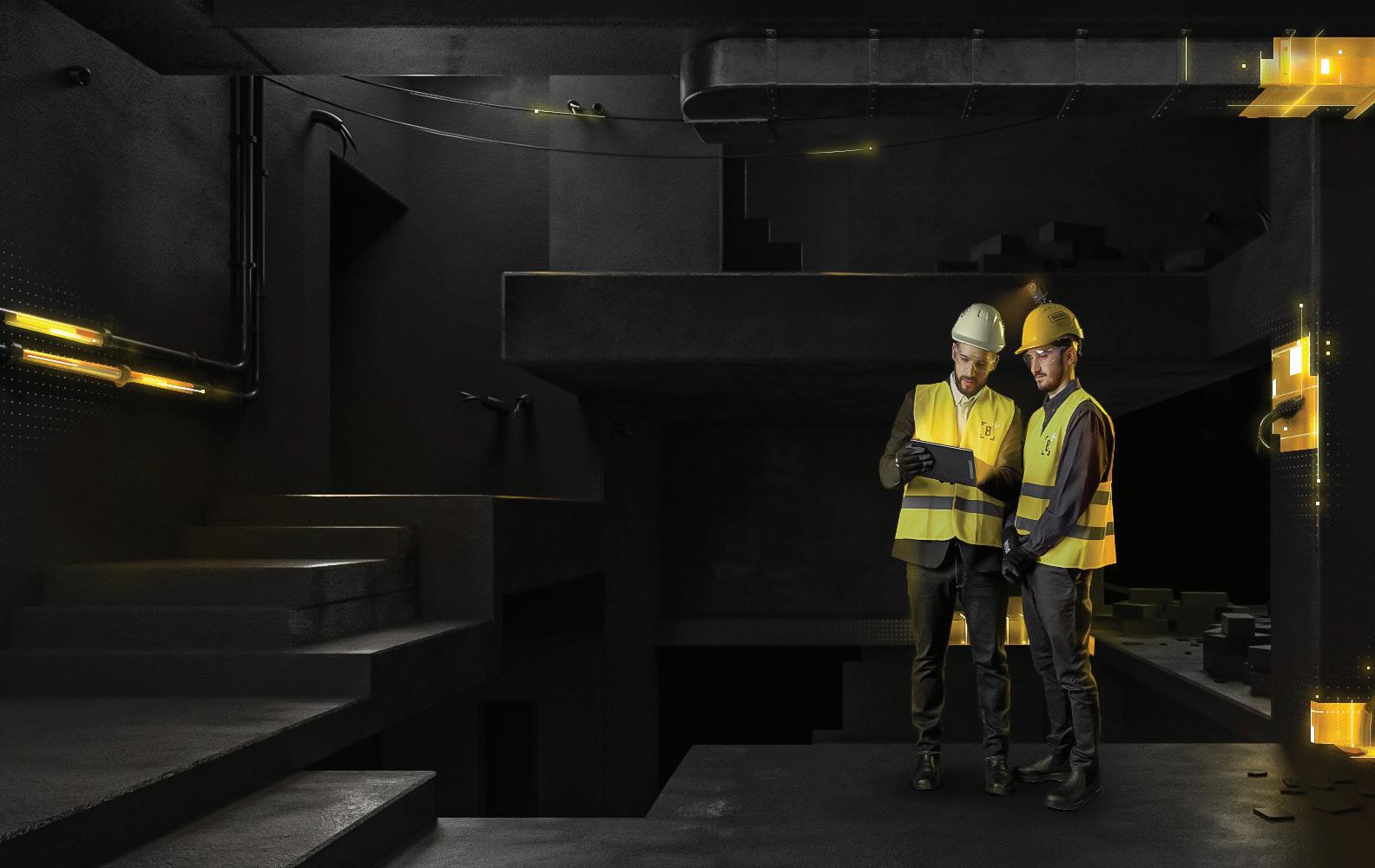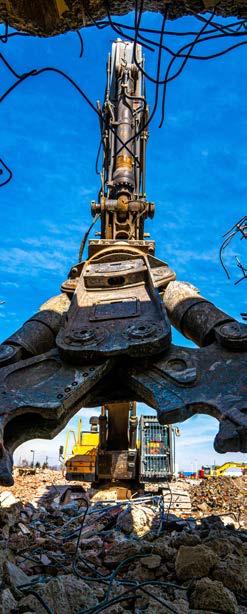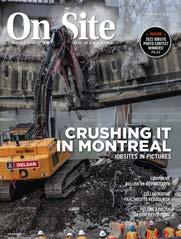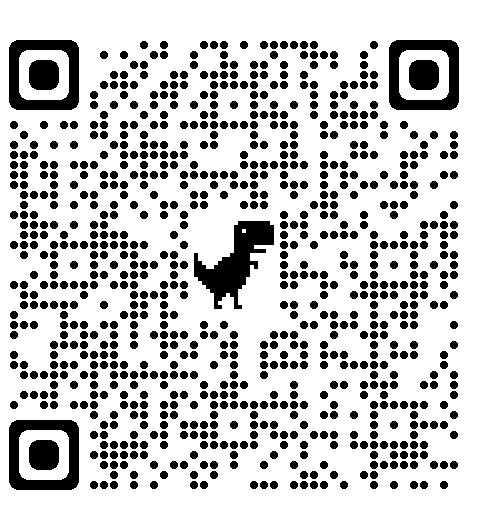2023 TECHNOLOGY REPORT
CAMERAS IN CONSTRUCTION
Page 34
CYBERSECURITY FOR CONSTRUCTION

Page 38
5G ON SITE
Page 40
TELEMATICS FOR EFFICIENCY
Page 42

CAMERAS IN CONSTRUCTION
Page 34
CYBERSECURITY FOR CONSTRUCTION

Page 38
5G ON SITE
Page 40
TELEMATICS FOR EFFICIENCY
Page 42

We analyzed 64 global construction projects, representing 82 years of combined construction time, to explore construction site inefficiencies at a more granular level than ever before. Our research identified 4 metrics of inefficiency that are often overlooked and can be used to optimize efficiency going forward.
The number of trades that return to a work zone to finish incomplete work (not including rework).



The instances of activities being started out of sequence in each area.



Buildots is delighted to feature in the Construction Technology Report emphasizing the importance of technology in the construction industry. When my co-founders and I founded the company in 2018, the industry was being inundated with advanced technological innovations, but there was still a lack of tech to address its core challenge — how can we deliver projects more efficiently?
With today’s challenges, the question is even more relevant. Facing skills and labour shortages, design complexities, new regulations, financial uncertainty and more, professionals are still expected to successfully deliver on construction projects.
We recently published a study in which we analyzed 64 projects worldwide, the equivalent of 82 years of combined on-site construction, to measure project efficiency at a more granular level than ever before. Our research revealed the impact today’s challenges have on our industry’s productivity, but also the potential for improvement.
We highlight four metrics of inefficiencies, from low utilization of available work areas to weekly trade output inconsistencies — metrics that are a result of challenges project teams previously had no advanced tools to help with. But there are tools and methodologies now, from AI to Lean Construction, that can support teams. We’re proud to be one of these tools. Buildots AI-based technology fully automates progress tracking for enhanced control and visibility on-site.
We set out on a mission to make construction more efficient — not accepting the status quo. We’ve been helping construction professionals do what they do best, with less stress and more certainty. It’s exciting to see the change the industry is going through, and it’s a great honour to be part of it.
All my best,
Aviv Leibovici, Co-Founder and Chief Product Officer at Buildots
Cameras and imaging systems are changing construction sites. From site mapping to project tracking, cameras, drones and lasers are providing very accurate and precise information that can be harnessed to produce more efficient builds.
On March 20, three industry experts, Steve Mahaney, VDC area manager for Eastern Canada at EllisDon; Cody Nowell, construction services manager at PCL Constructors; and Steve Rollo, national BIM/ VDC manager at Graham, took part in a virtual discussion, moderated by yours truly, the editor of On-Site Magazine to share how these technologies are being used by their teams on sites throughout Canada.


And these technologies are varied, from traditional video-shooting drones to hardhat-mounted cameras and laser imaging systems that generate point clouds – and
even photo-realistic 360-degree visuals. Thankfully, the panellists were up for all points of discussion.
To help illustrate the benefit of using drones on a project, Mahaney provided attendees with a special aerial look at the Centre Block Rehabilitation Project currently happening in Ottawa, with video provided by PCL EllisDon Joint Venture, the team working on the project at Parliament Hill.
“The teams use the drone data quite frequently,” he said, explaining that the images have been used by the BIM team in its modelling, as well as for logistics and planning purposes. “It’s an important asset that they continue to use on a daily basis.”
He and his team at EllisDon use both drones and 360-degree imagery on a regular basis for most projects and view the use of this technology as an important part of the
company’s business.
“The amount of data and how quickly you can capture it now provides our project teams with really great insight and also validates design from the consultants or the trade contractors,” he explained. “We can take that scan data and overlay it with models and see where we’re at.”

“Being able to get cameras and drones into the hands of all of our project teams, not just the mega projects, I think is something that we’ve seen a lot of advantage from,” said PCL’s Nowell. “When it comes to laser scanning, while the hardware is a little bit more expensive, I would say there are use cases, depending on the type of project.”
He says that getting a good representation of the existing geometry is very informative to his company’s BIM models, ensuring that the live site matches the
model as closely as possible.
Graham’s Rollo is also a fan of drones. “We’re definitely seeing a huge uptick, especially in the last two years in Canada,” he said. “That, along with the 360 cameras, almost becomes just a natural thing. It’s not even discussed if it’s going to be used on a project anymore. It’s just part of a project kickoff checklist.”
Although there will still be some projects and situations where drones are not a perfect fit, they can be especially helpful to map out large sites, and to capture visuals where space can be difficult to otherwise navigate.
“On larger sites, it’s far easier to get a drone up in the air to map the site out,” explained Rollo. “If we’re doing a large stretch of road or bridge, bridge, we can get the high-level scope a lot easier than just taking pictures.”
“Here in Ottawa, we do a lot of rehabilitations. Looking at older buildings, the drone technology definitely comes into play,” added Mahaney. “At Centre Block, they use it for masonry, taking a look at that going up to the Peace Tower.” With each

block expected to be rehabilitated during that project, the early look will help both with the restoration work and the rebuilding of the structures.
“The really nice thing I like about drones is being able to geo-reference things,” added Mahaney. “Being able to put a ground control point in, and then fly a survey flight, suddenly you’re providing the client with a geo-referenced map of exactly where that underground piece has gone.” Being able to reference the map years later to identify where pipe or other buried infrastructure is located is a major benefit to the contractor, and to the client, he explained.
“The nice thing about drones is that you can harness a lot of different types of data,” said Nowell. “You can use it for logistics planning, you can use it for quantity takeoffs. You can use it for inspections. There’s a lot of different use cases that you have with drones.”
“I think one of the biggest things that we leverage it for is our progress tracking and QA/QC practices, so that we can have that different visual of the big picture of the project to track how the project is going,” stated Rollo, adding yet more advantages to the use of visuals on a site. “We also
leverage it pre-pour it to identify the PT cable layout… things of that nature… it’s a lot different to get it from that overhead perspective, and then tie that in and align it with the design intent, model or drawings… We use it heavily as part of our progress tracking and progress turnover packages that we present to the client afterwards.”
Use of drones is not without its challenges, risks and regulations, however.
“The RPAS [Remotely Piloted Aircraft Systems] pilot has to be aware of what those inherent risks are,” advised Nowell. Once the risks have been assessed, a decision can be made on whether a traditional approach or the flying digital technology is best for the situation.
“There’s a perception out there that even with a sub-250-gram or smaller drone that basically anyone can just go out and fly,” said Rollo. “And while that’s true to a certain extent, there are a lot of rules.” He explained that failure to follow proper procedures, file appropriate flight plans when necessary, and encroaching into restricted airspace can result in Transport Canada shutting the flight down, and possibly
issuing financial penalties. “You need to be conscious of that,” he advised.
“Client communication is another key part,” said Mahaney, explaining that not all clients would understand why a general contractor would want to fly a drone, and may be worried about their airspace security. He suggested communicating details about what information would be gathered, and how it would be gathered, including how RPAS requirements are to be safely met, can ease the client’s mind.
While much of the discussion focused on drone technologies, panellists also spent time discussing how laser scanning is also assisting contractors work up 3D models so that they can work more effectively and efficiently.
“I think we where we see the most value is where we are recapturing the existing geometry,” said Nowell. His company used laser imaging technology to help with the build of a new 10-storey building on top of an existing parkade structure. New foundations were needed, which necessitated the cutting of openings in the slab and driving piles, but it was discovered that the as-built information was not accurate, which would have created significant problems.
“We use the laser scanner to capture that geometry, adjust the design and make the changes before the piling rig was even mobilized,” he said. “And that’s really where we see tremendous value in those applications. Yes, that laser scanner is an expensive piece of kit. But in the right
application, it’s a lifesaver.”
“With rehabilitations, we like to have the laser scanner go out and do the ‘as-found’ conditions, so that we can really validate the information that we’re getting,” said Mahaney, who explained that the measurement accuracy has also helped in other ways as well.
“Just looking at the speed of the laser scanner now, you’ll get a superintendent who says, ‘Hey, I need a custom grate for this entryway, can you come scan this?’ And it’s like, ‘Yeah, that’s a 15-minute job, no problem, we’ll get you the most accurate data,’” he said. “It’s a great tool for the project teams to be able to scan data and start taking measurements.”
Of course, that begs the questions, “Can I trust the data?” and “How do I know I have accurate and trustworthy measurements?”
“With photogrammetry… it’s this magic box. I take these photos, I put it into the magic box and magic spits out: I get these quantities, and this digital model, and this point cloud,” said Nowell. “Our teams are always so amazed with the data that we can pull from this thing, but how much do you really understand about what you’re capturing and what the outputs are? How are you verifying the accuracy of the information that you’ve captured?”
He explained that the software is so easy to use that can be easy to make mistakes, which may not be picked up right away.
“We’ve made a focus of trying to make sure that we’re training our people to understand what ‘good’ looks like, and to understand what common errors are,” he said. “If you’re turning over data that you don’t know what the accuracy is like, there’s big risks associated with that… there’s a lot that goes into making an accurate scan and capturing an accurate model that you can rely on. And it’s not just putting pictures into a software and then spitting it out.”
Of course, photos, videos and imagedriven apps can also help with project tracking to ensure that project errors are caught as early as possible.
“Something we implement on almost every single job that that we’ve done, at least on the building side, is a hardhat-mounted 360-camera,” stated Rollo. “Similar to doing our drone flights for select jobs, this has been going on, I would say for a vast majority of our jobs now, to be able to capture our progress.”
The use of the camera and app leans on the daily site walk that needs to be done anyways, but it has now become a handsfree experience that they don’t even have to think about.
“And they don’t have to walk the same path every time,” he added, one of the ways that the geo-referenced data differs from the traditional methods formerly used for progress tracking.
The fact is that imaging is changing the way that construction sites operate, and for the most part, technology is proving its value to project owners, construction managers and workers on the sites.
“The value cases are there, and they’re proven,” stated Nowell. “If you’re not there yet, you should be.”
“I think the biggest thing is that this is data that we need for our jobs anyways, and these technologies provide a very low-cost, efficiency gain to the project and are actually capturing the data accurately,” added Rollo. “Not only does it add a value benefit to the owner, but for your own internal record keeping, it’s huge value down the line, should that data need to be recalled at any given point.”
And for those who have already embraced the change, Mahaney says there are still next steps and technologies to look forward to.
“I think the next thing we have to look at is artificial intelligence,” he said. “Getting this imagery up into the cloud so that the machines can take a look at it, and we can start doing stuff like progress tracking and talking about billing and that sort of thing.”
To watch the full webinar, please visit On-Site Magazine’s YouTube channel, or visiting https://youtu.be/w1BqtR_U4Oc.
With photogrammetry… it’s this magic box. I take these photos, I put it into the magic box and magic spits out: I get these quantities, and this digital model, and this point cloud.”
Move away from tedious manual subcontractor payments, and put an end to headaches. Easily manage contracts and meet deadlines. Guarantee lien waivers are present and error free. Stop back and forth emails with automatic and custom waiver generation. All with ERP integrations with platforms like Viewpoint, CMIC, and Sage.

Help your entire team complete more projects—smoothly.
Stay in the flow.
GCPay.com

In early 2020, a major Canadian construction firm, announced it had been hit by a ransomware attack. Although the company provided reassurance that they were able to continue with business as usual, there’s no doubt that sensitive information had been compromised.
But they are not alone. In fact, they are in good company. More than 85 per cent of Canadian companies were hit by cyberattacks over a 12-month period in 2021, and companies hit by these attacks spent $600 million to recover.
With the cost and frequency of cyberattacks rising, construction companies and contractors must adopt technological solutions with the right supports in place.
Whether adopting a complete software solution or even using a drone to survey a single site, business owners and leaders will need to learn all they can about cybersecurity, including why the construction industry is being targeted, what the risks are, and how to protect against them.
Though slow to adopt technological solutions, in recent years the construction industry has become more digitally focused. Today, construction firms are using digital tools not only to send invoices and plan projects from the back office, but also on site to build walls and foundations or to survey progress in real time.

Portable devices such as mobile phones
and tablets are used regularly by a variety of workers, full-time employees and contractors alike. And even personal devices may be used to connect to Wi-Fi as well.
Each of these changes comes with benefits. For example, it may be a smart business decision to bypass the chronic labour shortage by building a brick wall with a robotic arm. Yet the change also leaves the industry vulnerable to attack.
Employees who are not careful to protect their own personal devices may not understand how susceptible they may be to bad actors seeking to infiltrate their systems. Business owners may not have the IT support they need in-house. And supervisors and other managers who work from home regularly may be unwittingly leaving their devices vulnerable as well.
Keep in mind, savvy cybercriminals
know the big construction companies are already protected, so they are also going after the small and medium-sized firms, the ones without an IT department or other support team on call. But there’s no reason to leave yourself vulnerable to attack.
THE MOST COMMON CYBERATTACKSCommon cyberattacks include:
RANSOMWARE
Ransomware is software designed to prevent a person or company from accessing their files. Cybercriminals take control of a company’s digital system and demand a ransom payment before releasing it.
While ransomware targets all types of businesses, the construction industry seems to be especially susceptible. In fact, construction firms – like Bird or France’s Bouyges Construction – accounted for nearly 10 per cent of all ransomware attacks in Canada in 2021, likely due to the rapid adoption of technology solutions and the lack of security around them.
In this attack, the criminal poses as an expert or trusted source and uses email to trick someone into sending money or sharing valuable information. The criminal can then use this information to his or her benefit, whether to gain access to banking or other financial information, or to steal money or other resources outright.
As the industry goes digital, the need to protect against bad actors is rising.PHOTO: © PANUWAT / ADOBE STOCK
Construction is vulnerable to such attacks in part because construction firms work with so many other entities. Whether it’s subcontractors or suppliers, goods and money flow back and forth regularly, making it a challenge to spot a false claim or a scammer among all the legitimate transactions. In addition, some construction projects begin as part of a bidding process, which makes the details of a particular job public knowledge and easier to exploit.

For contractors working with multiple companies on multiple projects, security can come down to the strength of a single password. A bad actor gaining access to a system with one vendor may be able to gain access to multiple systems if they are linked.
That’s a risk in the construction industry, where subcontractors may work with a variety of general contracting firms or suppliers who together complete a single job. The subcontractor must have access to the digital project management system at the larger company, but this may create a weak link in the digital system that criminals would love to exploit. And a breach could impact any of the connected companies.
With so many traps, construction firms must be careful when they adopt a digital solution. Technology can make life easier, but only if it’s secured and used appropriately. The proliferation of technology on-site only magnifies the risk, with an increasing number of devices and users to support and protect from attack.
Construction leaders looking to adopt new technology must stay on top of security needs and best practices to protect themselves, their businesses, and other companies they do business with.
Old software and obsolete applications are some of the easiest ways for cybercriminals to gain access to your organization’s data. In many cases, an exploit is made possible through vulnerabilities that may have been overlooked in a program’s outdated coding. Be sure to update software regularly and patch vulnerabilities.
Computers and hard drives, cell phones and tablets, and even printers and copy machines contain data that may be valuable to a cybercriminal. Before disposing of any equipment, be sure that the data is completely wiped so that it cannot be recovered.
Many of your employees may not understand how serious the risk is. Include cybersecurity training as part of your annual safety training and take it seriously. Teach all employees how to handle confidential information, how cybercriminals try to exploit weaknesses, and the different types of cybercrimes. Create a process for reporting suspicious activities.
Where a simple password isn’t enough, multi-factor authentication is a more advanced system that requires a user to verify his or her identity through multiple pathways. For example, in some cases a user may be required to sign in with a password as well as a system-generated code sent to a mobile device.

Adding extra layers of security makes it
harder for cybercriminals to gain access to your sensitive data. Confidential information such as invoices, contracts, and other financial and legal documents all belong behind that extra security. Be sure employees have to submit multiple credentials before gaining access.
The risks are multiplying. And with human error generally understood to be the most significant concern, it’s no surprise that actively managing the risk can make a real difference. Insurers understand this too, and they are requiring construction companies to prove they’re a good risk before offering coverage. In 2023, construction professionals who understand cybersecurity, and who can demonstrate their care, will have the edge.
Jonathan Weekes is cyber leader at global insurance brokerage Hub International. He has more than 13 years of experience in commercial insurance with a focus on professional liability and cyber risk.
From two-way radios to the now-shuttered Clearnet Mike push-to-talk mobile phone network, wireless technology has been used on construction sites for decades. More recently, site communication has meant not just speaking from a distance, but also sharing digital drawings, photos and videos.

This new way of working means jobsites must be connected to the internet. That can be hard to achieve when infrastructure is yet to be built, but Wireless Wide Area Networks (WWANs) and the latest generation of cellular technology, 5G, fit the bill to help move data throughout the construction lifecycle.
A WWAN is a telecommunications network that uses public or private cellular routers or adapters as infrastructure to connect various networks and cloud servers. Enterprise WANs allow users to share access to applications, services, and other centrally located resources. WWANs connect people, places and things anywhere, and have become a staple of enterprise networking.
Cellular wireless has always been ideal for failover and connecting critical assets in places wires can’t go, and today’s cellular networks are more pervasive and getting faster with the deployment of Gigabit-Class LTE and 5G. With flat-rate pricing beginning to eliminate overage anxiety, WWAN is becoming the preferred broadband connectivity for fixed sites.
5G, in particular, has been getting a lot of attention as it continues to roll out across Canada. If you replaced your phone in the last year or two, there’s a good chance it has a 5G modem in it. The specification uses more channels than 4G, which means faster data transfers. It can handle more devices at once, and is better-suited to managing the array of smart devices and sensors now involved in the construction workflow. It is also more responsive.
The 5G specification includes low-band frequencies, which are about as fast as 4G, and mid-band and high-band frequencies that can be 10 times faster.
What does this mean for construction? The amount of data flowing through a modern construction site requires a reliable and fast internet connection that can’t always be provided by Wi-Fi, especially in the early stages of a project.
5G can deliver a fast wireless connection to a site with less of an investment in hardware. A traditional wired connection can take up to 120 working days to set up, and it’s costly to relocate wires as a project proceeds. In contrast, 5G can be deployed earlier, easier and with less hardware. Set up can be handled at a central office and remote sites can be deployed within a day.
The technology supports connectiondependent activities that are already happening on construction sites. For
example, drones serve many functions in the industry: gathering visual information that can be used to create topographic maps and 3D models, assessing the location of equipment, taking measurements, and creating photo and video records of a project’s progress. All of this involves a lot of data.
But the need for bandwidth is only part of the story because drones need to be piloted. With 5G’s low latency, they can be operated from a distance without lag.
Sensors are also playing a greater role in the industry, during and after construction. Internet of Things (IoT) sensors can detect humidity levels that might affect materials and detect gas and chemical leaks. Smart sensors affixed to rebar and embedded in concrete aggregate can send data to the cloud via 5G. This helps ensure the quality of the work and minimizes guesswork.
Sensors can also help track assets on sites, note when supplies are needed, and mark when they have been delivered.
Other devices on sites include cameras, which capture photos and videos to track project progress, provide security and identify safety issues. Those files need to be transferred, usually in real-time. Additionally, wireless WAN is an excellent solution for mobility applications. Managing fleets, providing in-vehicle Wi-Fi for mobile data transfers, and video surveillance for added security can all be enabled using the same 5G network infrastructure.
Contractors are also increasingly turning
to specialized construction management software to manage all this information. This software, too, needs connectivity in the field.
Superintendents now walk sites, tablets in hand, accessing BIM documents, drawings, project specifications and worker schedules. The digitization of construction management started with obvious quality-of-life improvements, such as being able to send new drawings from the office to the field instantly, and has seen the emphasis shift from physical documents and disparate programs and files to comprehensive platforms that manage all aspects of a project.

Setting up a WWAN must factor in several considerations. For example, will the network be in place to enhance network failover or to augment existing network bandwidth? Will it be the primary link, such as in the case of an unserviced job site, where there are no wires to connect to?
An enterprise network solution provider
– in particular one focused on wireless network edge solutions – can help to assess the best strategy and determine the scale of the deployment needed for a particular site.
5G will not be an option for every construction site and it isn’t available in every city, so companies considering using it should assess availability as a first step. As well, local coverage and speeds can vary.
The nature of high-band frequencies means 5G signals behave a little differently than 4G as well. The higher frequencies offer greater speed and bandwidth but carry over a shorter distance; about 500 meters. The signal can be degraded by brick, cement, and the human body. Low-band and mid-band 5G frequencies are less prone to signal attenuation, while still offering high speeds and low latency.
As with any technology implementation, companies should understand any security-related considerations.
Fortunately, 5G was developed with security in mind and will scramble commu-
nications between a user’s device and a cell tower. It also allows for different networks to use the same infrastructure but be separated from each other. This could allow a company to provide subcontractors with access to one network through on-site hardware, but not another containing sensitive files.
While 5G includes built-in security enhancements, it also introduces more complexity. With more IoT devices, there is more rist of compromise. To mitigate security risks, contractors can turn to new security measures such as zero trust network authentication (ZTNA), and practices like keeping devices updated with the latest software and creating back-ups of data.
As construction becomes more reliant on data, there’s a need for high-speed internet connection, which 5G can provide.




